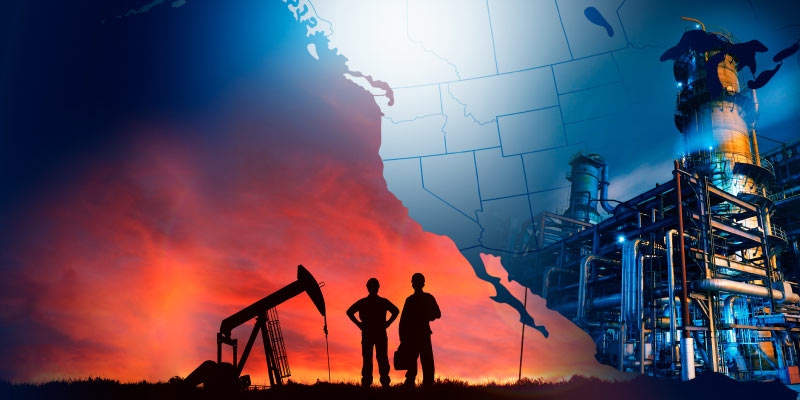Effective Tax and Royalty Rates on New Investment in Oil and Gas after Canadian and American Tax Reform

In the wake of the January 1, 2018 US tax reform, multinational businesses with US operations are re-evaluating investment, financing, and other operating activities to determine their most profitable strategies. Policy makers in other countries are also revaluating their business tax systems to determine the best course of action in response to sweeping US tax reform. On November 21, 2018, the Canadian federal government announced its response to the US reform by introducing accelerated cost recovery for capital expenditures.
This study provides an analysis of Canadian oil and gas tax competitiveness in the wake of US tax reform and the recent Canadian response. We estimate the impact of all taxes and resource levies on investment returns by estimating the marginal effective tax and royalty rate (METRR) on capital (costs related to other inputs such labour and energy are not included). This is a summary measure that accounts for corporate income taxes, sales taxes on capital purchases, capital taxes, transfer taxes, stamp duties, profit-based resource levies, and royalties as a share of the pre-tax rate of return on investments. The modelling is based on a “time-to-build” model that used two phases of production: (i) exploration and development to prepare reserves (capital building) and (ii) extraction from reserves (use of capital).
The purpose of resource levies is to collect resource rents on behalf of a government or, in the case of private ownership, the landowner. Thus, one might argue that royalties and other resource levies are payments made by private firms for the use of resources owned by the government. Resource rents are the excess of revenues over the opportunity costs of using labour, capital, and other inputs in production. We focus on marginal investment decisions in that profits are just sufficient to compensate for investors who could invest in alternative assets with the same after-tax returns, net of inflation and risk. In other words, no economic rents are earned at the margin. Taxes, including resource levies, discourage marginal investments even though there are no rents to be earned and therefore should not be subject to resource taxes.
We compare Alberta, British Columbia, Saskatchewan, Newfoundland and & Labrador, and Nova Scotia, representing over 95% of Canadian hydrocarbon production with 15 US states, including the ten highest producing jurisdictions for both oil and gas, representing over 79% of oil and 86% of natural gas production in the United States: Alaska, Arkansas, California, Colorado, Kansas, Louisiana, Mississippi, New Mexico, North Dakota, Ohio, Oklahoma, Pennsylvania, Texas, West Virginia and Wyoming. To the extent that the METRR is higher, there is less incentive to invest in a particular jurisdiction, all else being equal. Of course, various non-tax factors such as production, exploration and development costs, distance to markets, the quality of the resource, skilled labour supply, regulations, infrastructure, political risk, and perhaps most important, market price, also affects a firm’s investment decisions. All else being equal, tax will have some impact on investment—as found in numerous economic studies mentioned below—but it is only one among several criteria that impacts investment.
For oil, we find that Canada’s weighted average METRR has moved significantly below that of the 2018 post tax-reform United States as a result of the accelerated depreciation announced by the Canadian federal government on November 21, 2018. This follows a period after US, but prior to Canadian, tax reform, in which the two were neck and neck (on average, 28.5% for Canada and 28.6% for the United States, based on provincial/state jurisdictions included here), and a prolonged period prior to US tax reform when the US METRR was much higher at an average of 33.9%. Both Canada’s package of accelerated depreciation, and US expensing provisions for short-lived capital (primarily machinery) in the recent tax reform, are legislated to be phased-out after 2027. It is worth noting, Congress has extended bonus depreciation for machinery several times since 2001, depending on the state of the economy.
Internationally, Canada is less tax competitive compared to Australia (24.7%) with its unusually generous treatment of exploration costs, but much more tax competitive than Brazil (66.5%) with its various tax and resource levies impinging on investment. Canada provides some tax advantage compared to Norway (32.4%) but less so relative to the United Kingdom (5.8%) (Bazel, Mintz and Thompson, 2018; authors calculations).
For Canada and US oil in 2018, Saskatchewan levies the highest METRR on oil investments (35.9%) followed by Louisiana (34.4%) and Alaska (32.9%). The lowest METRRs are found in Nova Scotia (10.0%), Newfoundland & Labrador (7.4%), and Pennsylvania (19.7%).
For natural gas, the results differ slightly. Canada’s METRR is on average 27.0%, roughly 1.5% less than the United States (28.5%). As with oil, Canada is less tax competitive compared to Australia and the United Kingdom and more tax competitive than Norway.
Natural gas investment faces a higher METRR largely as a result of revenue-based resource levies on natural gas, which has a lower price-cost margin compared to oil. Saskatchewan (36.6%), Arkansas (35.6%) and Texas (35.3%) have the highest METRR on investments. Nova Scotia and Newfoundland & Labrador are lowest at −10.0% and 7.4%, respectively, followed by Pennsylvania at 21.3%.
Authors:
More from this study
Subscribe to the Fraser Institute
Get the latest news from the Fraser Institute on the latest research studies, news and events.



